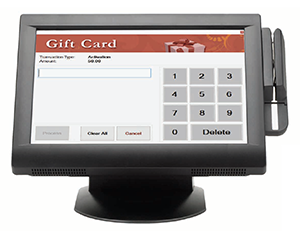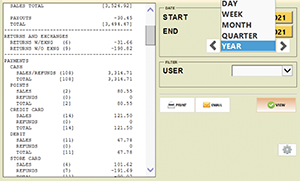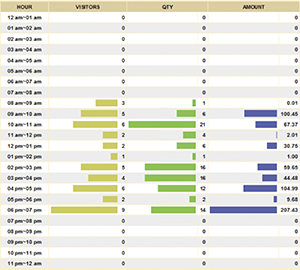Diligent POS Data Analysis Brings in Money!
The age of data has arrived. IT companies like Google, Apple, and Amazon, so called “Big Brothers”, are exploiting big data to devise their strategies for marketing, human resources, and public relations. They are spending billions of dollars to gather these money-generating data because they can maximize profit while minimizing spending relying on the data.
Some say this sort of data utilization should not be just for IT giants. Retail stores are already in possession of these valuable data to be utilized for consumer analysis. The data lies in the POS system you have at your store. The POS system you are using to manage inventory, place orders, and connect cash registers can provide highly customized data for your business, not available from other sources. If you use the data proactively, you could expect cost savings in marketing and overhead spending and improved efficiency. Then, what are the data you should keep an eye on?
Reduce credit card processing fees using credit-to-cash sales ratio data
When you are running a retail business, you would encounter unexpected costs from time to time. One of them is credit card processing fees; the tiny processing fees can accumulate to burden you in the end. If you know and take a meaningful look at the credit card transactions for the gross amount in fees as well as the percentage they account for in your revenue, you can reduce some of the burden. If you know the range of the credit card processing fees at your store, it should tell you what you could do about it.
Golden Key POS’s Executive Manager Scott Yoon recommends gift cards with no processing fee.

Gift card screen of Golden Key system displays a standalone gift-card feature that does not incur processing fees. (Image Courtesy of Golden Key)
“Well, gift card feature built in the POS is a typical solution. There is a per-transaction fee for credit card payment. If you purchase a gift card, the single payment can cover multiple checkouts, so the fee incurs only for the gift card purchase. For example, if you repeat $10 transaction for ten times, retail business ends up paying the transaction fee ten times. However, if you process a $100 gift card purchase, the credit card processing fee incurs only once.”
An important to thing to remember is that all businesses have different sizes of total credit transaction amount. Business owners can easily access and analyze the data because the POS system keeps records of these types of information. Let’s save the transactional cost by using gift cards in amounts customized to your retail store.
Sales records by dates and by weather can be used to run promotional events on a right date.

Displays for sales records by time, week, month, and year
Sales records in the POS can be retrieved by month and year. You can first retrieve data per year, take a look at the peak month, and find out the dates with high numbers in sales. You can decide when to run a promotion based on the number of buying customers on a specific day and per-customer purchase amount.
As all businesses are unique, you should have varying factors contributing to sales. However, most market experts agree that you should focus on the weather and holidays in addition to special circumstances such as the issuance of stimulus checks. To clear out the inventory or to promote a new store opening, you should use the collected data to pick an appropriate date for the sales event.
POS system does not track the weather history, but you can simply look up weather of a specific date on the internet. Hence, it is possible to compare the sales data with corresponding weather data. As to stimulus checks, the first round was in the second week of March 2020, the second round in the fourth week of December 2020, and the third round in the third week of March 2021. If you count the days from the stimulus payout dates to the dates with increased sales, you should be able to forecast good dates for promotion.
Efficient human resource management and setting business hours based on the number of customers by hour

Displays the number of customers by hour
Wages probably account for the greatest portion of business operation cost. To save wages, you should facilitate the efficient placement of human resources. To begin with, you want to have more employees when you have more customers. Next, you can allocate specific tasks to the employees at work. If you have a general idea about the hourly placement, you can also assign a certain time to complete individual tasks. For example, you can set a lunch hour during low customer traffic hours, and you can train employees to perform cleaning and inventory duties in off-peak hours.
On the other hand, you can assign every employee to customer service during the peak hours. Even further, you can have flexible business hours. Sometimes when you spare employees from reporting to work during off-peak hours and wasting their time, they end up providing a better customer service.
Shelf and inventory management using per-category sales data
The most common approach to boost sales is to analyze product sales data. For beauty supplies, you typically have hairs, chemicals, accessories, wigs, and so on, and sub-categories can be further utilized for data analysis. For example, you can divide hairs into braids, weavings, and clip-ins, and chemicals into hair oils, shampoos and conditioners, and glues.
Even within a category, products can have varying contribution to the business revenue. We can use the data to improve how to manage inventory and how to organize product display. Let’s say hair oils in chemicals category recorded the following numbers:
Argan oils: 50% of total oils sales
Jojoba oils: 20%, and
Coconut oils: 10%.
You can conclude that jojoba oils and coconut oils have passed the introductory, growth, and maturity stages and entered the decline phase. Even if the supplies run low, you would not place orders in the same amount but reduce the order size by replacing it with more orders on argan oils. You should also display items accounting for a large proportion of revenue in high visibility areas while promoting sales of declining items during events.

Golden Key Executive Manager Scott Yoon interviewing with BNB
As such, you can contemplate various marketing strategies and cost saving tactics based on the easy-to-understand data. Recently, POS system providers are accumulating more and more data and gathering inputs from people working in the industry, leading to advancement in service and functionality, which will eventually broaden and sharpen the way you can utilize data.
Executive Manager Scott Yoon showed his confidence in the future of POS while saying, “we are making an effort to update POS programs every year checking off the list of update ideas based on technological development and feedbacks from business owners, and the advancement will only accelerate.”